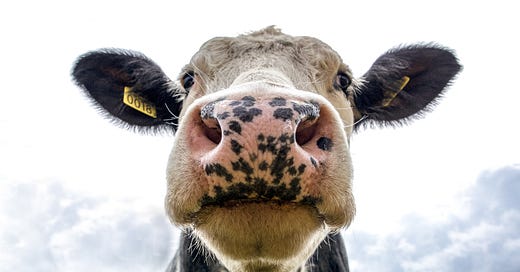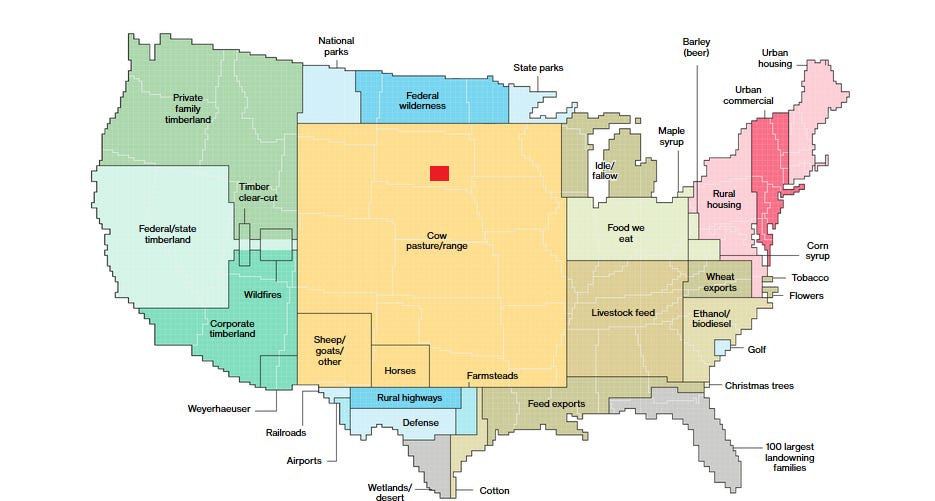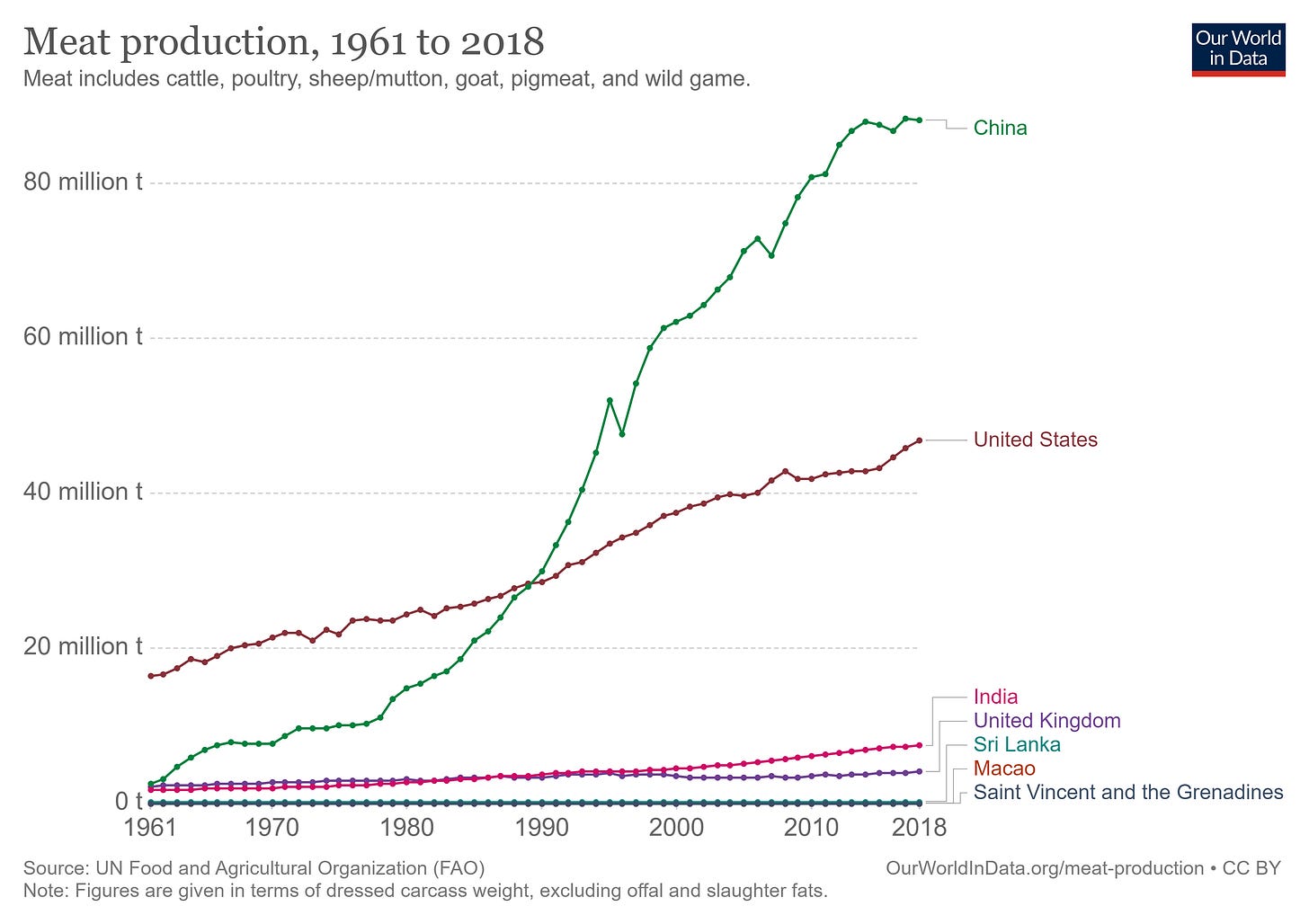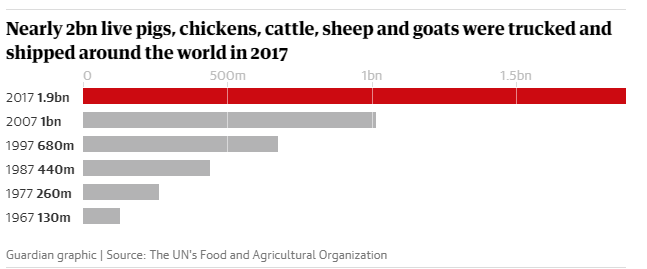The Planet, Disrupted
One-third of all land on Earth is being used to provide meat. That's about to change.
An alien spaceship enters the solar system and heads for Earth. The captain hushes the excited crew and turns to the science officer.
“Well?”
“Good news, captain, we’re picking up signs of life, and long-range scans indicate the planet has been transformed by one lifeform in particular.”
“Excellent. Make contact.”
A short time later, a cow grazing a field somewhere in Iowa lifts its head to see a small drone bobbing in the air and squawking gibberish.
It’s a silly little story, but it reveals a fundamental truth.
A visitor arriving here for the first time would see that 1/3 of the land on our planet is not occupied by people — but by livestock.
That’s over 40 million square kilometers set aside for domestic animals and the crops to feed them. An area bigger than Russia, Canada and America combined.
The map below illustrates the point vividly. I have drawn a solid red line around the share of land in America used for livestock and their feed. The striped red lines are for feed that’s exported to other countries.
This is really a map of two Americas.
In one America, we have an iPhone in our pocket that’s 100,000 times more powerful than the computer that took us to the moon.
And in the second America, livestock roams the land much as it has since we first domesticated animals over 10,000 years ago.
We still haven’t figured out our oldest industry. We managed to replace the horse with airplanes, but for some reason we can’t replace the cow.
Until now.
Technological disruption is finally coming to livestock. And if the experts are right, that map above will start to look like the map below, with America’s entire livestock industry contained inside the little red dot.
That’s the good news.
But before we dig into it, we need to talk about some bad news first. Because things might get worse before they start to get better.
Here’s the problem. Much of the livestock in the world today is used to feed people in the West, who typically eat over 100kg of meat a year whereas people in India eat as little as 5kg.
But as the developing world gets wealthier, they’re acquiring a taste for the Western diet.
And as you can see in the graph of China’s soaring meat production, that spells trouble.
Because there isn’t enough land on the planet to feed everyone a Western diet. It’s not even close.
So this is where we stand today.
We’re already using an area the size of Africa to raise livestock, while the demand for meat and milk is growing faster than ever.
The question is how do we get from this predicament to that little red dot on the map we saw earlier?
Let’s start with ice cream.
The world loves ice cream. And just as we’re seeing with demand for meat, the demand for dairy is spiking in the developing world. By 2026 we will consume $90 billion of the stuff compared with $64 billion this year.
That adds up to a lot more livestock and pasture just to keep the world happy with a double scoop of chocolate mint.
Unless we can do something that short-circuits the process entirely. Like making ice cream without a cow.
This actually happened last year. A bioengineering startup called Perfect Day created the first ice cream for consumers that wasn’t sourced from an animal. And it’s incredibly clever how they came up with it.
The secret to making great ice cream is contained in the milk proteins called whey and casein. They provide the creamy quality that pulls shoppers into the frozen foods section.
But instead of sourcing these proteins from cows, the researchers at Perfect Day were able to re-engineer them within fungi. The proteins are identical, but instead of arriving in your bowl through a process that requires pastures, animal feed, cows, antibiotics, hormones, milking, pasteurizing and much more; these proteins are produced on site in large, hygienic tanks.
Identical to the milk protein from cows, but without the cow.
Now that Perfect Day have succeeded with ice cream, they and similar companies are turning to cheese, yoghurt and milk itself.
This is how you disrupt an industry. And it’s just the beginning.
Perfect Day has raised $360 million from investors who believe technology is finally about to reshape the livestock industry. One of their biggest investors is the Singapore government, through its investment vehicle Temasek.
It’s no surprise why Singapore is keenly interested in companies like Perfect Day. With just 1% of its land available to grow food, the densely urbanized island imports 90% of its calories from as far away as the United States and Europe.
To reduce its dependence on imports, the country recently launched an incredibly ambitious program to produce 30% of its food locally by 2030.
A big part of this push is to replicate Perfect Day’s success in Singapore, but with meat. It doesn’t sound pretty but it goes something like this.
Stem cells are extracted from animals like chickens, cows, fish or pigs, and then grown in bioreactors until they emerge looking like a pinkish paste.
This is then mixed with other ingredients to create meat that we are familiar with like hamburgers, sausages and steaks.
The process is expected to take up just 1% of the land currently required by the livestock industry.
And that’s how we get our little red dot on the map.
Lab-grown meat, also known as cultured meat, will start appearing in stores as soon as next year. And by 2040, the bioreactors in Singapore and elsewhere should be providing about 35% of all meat consumed in the world.
After thousands of years of unrelenting expansion across one continent and then another, the age of livestock is finally coming to an end.
As billions of these domestic animals disappear from the planet’s surface, the changes are going to be quite extraordinary. Let’s run through some of the big ones.
Transportation
The movement of livestock is closely entwined with human history and culture. The word ‘drive’ comes from the herding of animals and many of England’s old drovers’ roads later became the country’s highways. In America, cattle drives gave us the cowboy and helped define what it means to be American.
Fast forward to today and the world spends $21 billion a year to transport 2 billion animals by truck and ship.
This doesn’t include air shipments. Australia alone exports almost 100,000 tons of meat by air every year.
Now imagine what cultured meat will mean for all of those trucks, ships and planes carrying billions of animals around the world. It’s over, because cultured meat can be made anywhere. It doesn’t depend on one country’s pasture or another country’s weather.
The bioreactor tanks that create meat can be installed where the customers are. Shipping will change from crossing the ocean to crossing the street.
We will probably see something similar to the microbreweries that are a common sight in our cities and towns. But now we will also have places that sell micro-meats, and they will be just as varied and sophisticated as any micro-brewed beer.
Ethics
This doesn’t need much explaining. This is how many animals are slaughtered every year just for meat, and not including the dairy and egg industries:
69 billion chickens
1.5 billion pigs
656 million turkeys
574 million sheep
480 million goats
302 million cattle
Health
Almost 80% of antibiotics in the United States aren’t given to people. They’re given to livestock, and this is leading to an alarming rise in antibiotic resistance that is spilling over into the human population.
The Centers for Disease Control in the US calls antibiotic resistance “one of the biggest public health challenges of our time,” responsible for the death of more than 35,000 people every year.
Then there are the infections from tainted meat including E.coli, mad-cow, listeriosis and salmonella. And of course the viruses that jump from livestock to people like bird flu, swine flu and the Nipah virus.
That pink paste we will get from sterile bioreactors doesn’t sound so bad now, right?
Land
The impact on the use of land will be dramatic.
We can get an idea of the changes by looking at Europe, where the decline of grazing has already helped forests expand by 90,000 km2 in just 20 years.
This is equal to an area the size of Portugal.
The return of woodland and other natural habitat has seen wolves reappear on the outskirts of Paris, while bears are returning to countries like Switzerland and Portugal for the first time in over 100 years.
I have seen this remarkable transformation for myself.
In Singapore I lived in an area called Dairy Farm (though the farm and cows were long gone by the time I arrived).
This picture is what it looked like when 600 cows roamed the hills under a merciless equatorial sun.
But before those cows arrived, this area was a forest.
In the 1850s, Alfred Russel Wallace spent weeks here avoiding tigers and leopards while discovering the new species that would later help him develop the theory of evolution at the same time as Charles Darwin.
Then the cows replaced the tigers and the forest was turned into a barren landscape. This lasted up until 1970s, when the cows were taken away and some of the land was turned into a park.
Now just decades later, this is is the same area today.
Credit: Guo Qi
This is what disruption is going to look like.
New technology is finally transforming our oldest industry and unleashing dramatic improvements in our health and environment.
We have been changing the planet for thousands of years.
Over the next 10 to 20 years, we are going to change it back.










